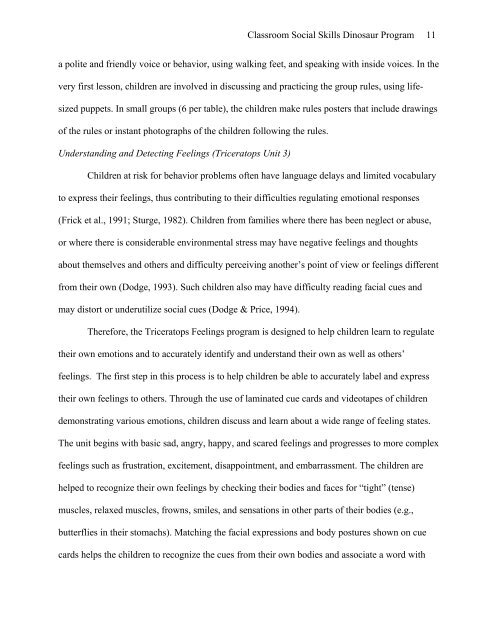Classroom Social Skills Dinosaur Program 1 Running head ...
Classroom Social Skills Dinosaur Program 1 Running head ...
Classroom Social Skills Dinosaur Program 1 Running head ...
You also want an ePaper? Increase the reach of your titles
YUMPU automatically turns print PDFs into web optimized ePapers that Google loves.
<strong>Classroom</strong> <strong>Social</strong> <strong>Skills</strong> <strong>Dinosaur</strong> <strong>Program</strong> 11<br />
a polite and friendly voice or behavior, using walking feet, and speaking with inside voices. In the<br />
very first lesson, children are involved in discussing and practicing the group rules, using lifesized<br />
puppets. In small groups (6 per table), the children make rules posters that include drawings<br />
of the rules or instant photographs of the children following the rules.<br />
Understanding and Detecting Feelings (Triceratops Unit 3)<br />
Children at risk for behavior problems often have language delays and limited vocabulary<br />
to express their feelings, thus contributing to their difficulties regulating emotional responses<br />
(Frick et al., 1991; Sturge, 1982). Children from families where there has been neglect or abuse,<br />
or where there is considerable environmental stress may have negative feelings and thoughts<br />
about themselves and others and difficulty perceiving another’s point of view or feelings different<br />
from their own (Dodge, 1993). Such children also may have difficulty reading facial cues and<br />
may distort or underutilize social cues (Dodge & Price, 1994).<br />
Therefore, the Triceratops Feelings program is designed to help children learn to regulate<br />
their own emotions and to accurately identify and understand their own as well as others’<br />
feelings. The first step in this process is to help children be able to accurately label and express<br />
their own feelings to others. Through the use of laminated cue cards and videotapes of children<br />
demonstrating various emotions, children discuss and learn about a wide range of feeling states.<br />
The unit begins with basic sad, angry, happy, and scared feelings and progresses to more complex<br />
feelings such as frustration, excitement, disappointment, and embarrassment. The children are<br />
helped to recognize their own feelings by checking their bodies and faces for “tight” (tense)<br />
muscles, relaxed muscles, frowns, smiles, and sensations in other parts of their bodies (e.g.,<br />
butterflies in their stomachs). Matching the facial expressions and body postures shown on cue<br />
cards helps the children to recognize the cues from their own bodies and associate a word with
















